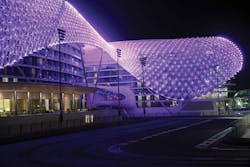local design is human design
An accomplished designer and ASID member, HKS Director of Interior Architecture Jennifer Kolstad, ASID, Assoc. AIA, has sought out the innovative, emotive, and unique for each of her award-winning projects. Her portfolio touches on hospitality, commercial, healthcare, and civic works but what they have in common represents Kolstad’s own philosophy on design. Sitting down with ASID, she explained how she effectively incorporates local design into her work, masters the balance between universal and regional, and how location tells a story that connects us all.
ASID: Although you design a range of spaces with all types of products, you’re especially
talented at incorporating local elements. How did your interest in local design come to be?
Jennifer Kolstad: I have been a Canadian expat for 15 years, living in the Middle East and the United States. My work has always been international requiring travel, exploration, and a deep appreciation for culture.
As designers, we naturally aspire to celebrate the human condition, wherever that is. “Local design” is our way of connecting people through cultural exchange. It is also the mechanism by which we design authentically. No matter our geographic location, design teaches us that we are not all that different. Our basic needs are universal. We seek out real experiences and look to make memories in the places we visit.
ASID: What unique attributes does local design bring to a space?
JK: We design projects that feel like they belong in the building, the neighborhood, the city, or the country within which they [are located]. We call this “regional contextualism.” Our design tells the story of people and place using unique materials, local artisans, shaping architecture to elicit specific emotions, and choreographing an experience. Sourcing local elements is the icing on the cake for designers. We love to curate regional attributes that speak to place.
ASID: Can you share some projects of yours that best exemplify a thoughtful balance between local and sourced products?
JK: In Abu Dhabi, I was fortunate to work on the F1 YAS Hotel (completed with Asymptote, Jestico + Whiles, and Richardson Sadeki), which is a 500-key luxury hotel located on the F1 track. When it opened in 2010, the building represented a future, progressive Abu Dhabi. The building is draped in a veil-like structural grid shell—prototypical in its design yet historically referential. The interior is also [sleek], white, and contemporary but consciously references local vernacular and cultural traditions making use of the abundant local labor force with available raw materials. An authentic experience unique to a specific place and time was achieved by making the best use of local resources.
ASID: Who are some of your favorite designers incorporating locality into their projects and why?
JK: I believe that all designers get excited about describing their local context. We work across borders and with partners around the globe as a normal part of our practice now. A “local” designer is one who takes the time to understand the culture, heritage, and audience wherever they are. I have loved working with Rockwell Group in the past for this very reason. They invest in research, crafting stories, and seeking out local artisans for collaboration with each project. Those special materials or installations often take center stage in their projects.
ASID: What is the biggest challenge you’ve encountered when focusing on bringing local features into design?
JK: Supply. We strive to invent materials or use materials in new ways on every project. On occasion our ambitions overextended our local resources. We must therefore balance quantity and supply with our desire to source and procure locally.
ASID: Where do you see local design headed in 2018?
JK: This year, the concept of local or authentic design will be at the core of our work. This is a direct response to the social and political global climate of 2017. A desire to feel grounded, safe, secure, and cared for will be realized through analogue solutions in design: tactility, hand-tooled materials, natural elements, and references to the natural landscape. We will seek to find authentic experiences, looking for the humanity in our physical world.
ASID: What advice would you give to other designers who want to incorporate more local elements into their projects?
JK: Local design is core to the original narrative and concept through each stage of work to specification and procurement. It is not about purchasing FFE (furniture, fixtures, equipment) and accessories at the end of the project but is foundational. Invest in research and physically visit the places where your project lives. Meet people, eat the food, feel the vibe. Translate what you learn into a physical experience.
